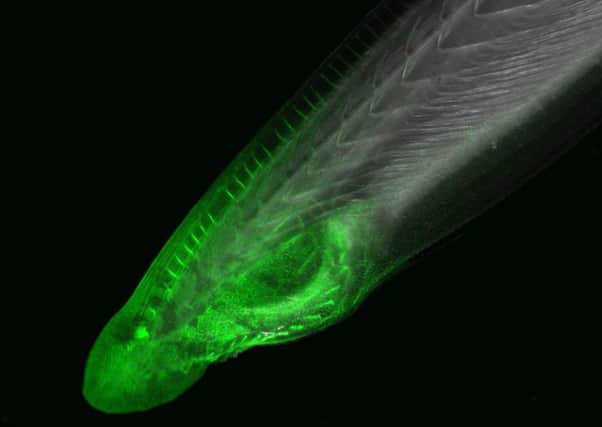Ancient fish sheds light on evolution of human brain


An international team involving researchers at the University of St Andrews has examined the amphioxus, also known as the Lancelet, which was thought to be a brainless, faceless fish. Instead, they found it has a very complex brain which confounds previous understanding of how vertebrate brains evolved.
The latest research, carried out by the Universities of St Andrews, Murcia and Barcelona and the Centre for Genomic Regulation, published in PLoS Biology, compared the amphioxus brain with current models of brain development in vertebrates, such as chicks and fish.
Advertisement
Hide AdAdvertisement
Hide AdThe new research casts doubt on the current textbook idea that the complex vertebrate brain evolved from a simple three-part brain composed of forebrain, midbrain and hindbrain. Rather, the new research suggests that the vertebrate brain must originally have formed from two parts.
Dr Ildiko Somorjai of the School of Biology at the University of St Andrews, co-author of the study, said: “Amphioxus is an amazing creature that can tell us a lot about how we have evolved. Humans have enormous brains with a large number of anatomical subdivisions to allow processing of complex information from the environment, as well as behavioural and motor control and language.
“Research in amphioxus tells us that even an outwardly simple brain may have complex regionalisation. It also strengthens the position of amphioxus as an important non-vertebrate model for understanding vertebrate evolution and development, with clear implications for biomedical research.”
Described as a “brainless, faceless fish”, amphioxus was found off the coast of Orkney during a marine survey in 2011, and is thought to be among the first animals to have evolved a structure similar to a backbone, the notochord.
Despite its appearance, amphioxus is not a fish. It has a primitive spinal cord which runs down its back, but no clearly defined face, no bones or jaws and a small brain with a single light-sensing “frontal eye”. It has changed so little for hundreds of millions of years that it has been described as a “living fossil”.
As the best living proxy for the vertebrate ancestor, amphioxus gives important insight into what humanity’s distant ancestor looked like, and how it might have behaved.
The research was jointly led by José Luis Ferran and Luis Puelles of the Department of Human Anatomy and Psychobiology of the University of Murcia; Manuel Irimia of the Centre for Genomic Regulation (CRG) in Barcelona; and Jordi García Fernández of the Genetics Department of the University of Barcelona, Spain.
AMPHIOXUS FACTFILE
This elusive species is regarded as a modern representative of the first animals that evolved a backbone.
Advertisement
Hide AdAdvertisement
Hide AdWith a nerve cord down its back, it has no face and, until now, it was thought it didn’t have a specific brain either.
It grows to about 5cm long and has a translucent, fish-like body, but without any paired fins or other limbs.
While Amphioxus does have some cartilage-like material around the gill slits, mouth and tail, is has no true skeleton.
They are usually found buried in sand in shallow parts of temperate or tropical seas.
In Asia, they are harvested commercially as food for humans and domesticated animals.
